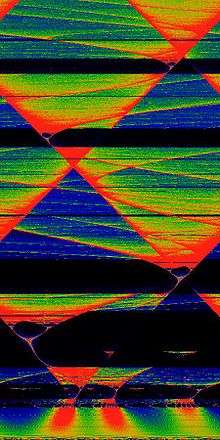Kaplan–Yorke map
The Kaplan–Yorke map is a discrete-time dynamical system. It is an example of a dynamical system that exhibits chaotic behavior. The Kaplan–Yorke map takes a point (xn, yn ) in the plane and maps it to a new point given by

where mod is the modulo operator with real arguments. The map depends on only the one constant α.
Calculation method
Due to roundoff error, successive applications of the modulo operator will yield zero after some ten or twenty iterations when implemented as a floating point operation on a computer. It is better to implement the following equivalent algorithm:
where the and are computational integers. It is also best to choose to be a large prime number in order to get many different values of .
Another way to avoid having the modulo operator yield zero after a short number of iterations is
which will still eventually return zero, albeit after many more iterations.
References
- J.L. Kaplan and J.A. Yorke (1979). H.O. Peitgen and H.O. Walther (ed.). Functional Differential Equations and Approximations of Fixed Points (Lecture Notes in Mathematics 730). Springer-Verlag. ISBN 0-387-09518-7.
- P. Grassberger and I. Procaccia (1983). "Measuring the strangeness of strange attractors". Physica. 9D (1–2): 189–208. Bibcode:1983PhyD....9..189G. doi:10.1016/0167-2789(83)90298-1.

